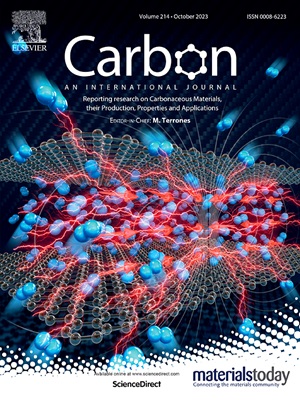低温碳化MOF/CNF气凝胶用于高性能微波吸收和热伪装
IF 10.5
2区 材料科学
Q1 CHEMISTRY, PHYSICAL
引用次数: 0
摘要
开发轻质、高性能、多功能的吸波材料已成为电磁防护领域的一大挑战。本研究制备了具有微波吸收和热伪装功能的ZIF-67/纤维素纳米纤维(CNF)衍生的Co-C /C气凝胶。通过在CNF上原位生长ZIF-67并进行低温碳化调控,构建了微米级骨架孔和mof衍生纳米孔共存的分级孔结构。同时,获得了分布均匀的Co纳米颗粒(20 ~ 30 nm)和富缺陷石墨化碳异质界面。Co-C /C气凝胶具有超低密度(16.21 ~ 17.35 mg/cm3)。在微波吸收方面,在2.4 mm的厚度下实现了6.87 GHz(覆盖Ku波段)的有效吸收带宽。这是由于多层孔隙的多重散射、低温碳化引起的界面极化增强以及Co纳米颗粒的磁损失的协同机制造成的。此外,该材料的导热系数为0.0492 W m−1 K−1,红外成像显示其具有显著的热信号屏蔽能力。本研究通过原位生长和低温碳化策略解决了传统mof衍生材料的结构崩溃和功能单一问题,为轻量化、宽带和多功能隐身材料的设计提供了新的见解。本文章由计算机程序翻译,如有差异,请以英文原文为准。
Low-temperature carbonization MOF/CNF aerogel for high-performance microwave absorption and thermal camouflage
Developing lightweight, high-performance microwave absorbing materials with multiple functions has become a major challenge in the field of electromagnetic protection. In this study, ZIF-67/cellulose nanofiber (CNF)-derived Co–C/C aerogel with an integrated design for microwave absorption and thermal camouflage functions was prepared. The hierarchical pore structure with coexisting micron-scale skeletal pores and MOF-derived nanopores was constructed through in-situ growth of ZIF-67 on CNF and low-temperature carbonization regulation. Simultaneously, uniformly distributed Co nanoparticles (20–30 nm) and defect-rich graphitized carbon heterointerfaces were obtained. The Co–C/C aerogel exhibited an ultra-low density (16.21–17.35 mg/cm3). In terms of microwave absorption, it achieved an effective absorption bandwidth of 6.87 GHz (covering the Ku band) at a thickness of 2.4 mm. This was attributed to the synergistic mechanisms of multiple scattering from hierarchical pores, enhanced interfacial polarization induced by low-temperature carbonization, and magnetic loss from Co nanoparticles. In addition, the material demonstrated a low thermal conductivity of 0.0492 W m−1 K−1, and infrared imaging revealed its significant thermal signal shielding capability. This study addressed the issues of structural collapse and functional singleness in traditional MOF-derived materials through in-situ growth and low-temperature carbonization strategies, providing new insights for the design of lightweight, broadband, and multifunctional stealth materials.
求助全文
通过发布文献求助,成功后即可免费获取论文全文。
去求助
来源期刊

Carbon
工程技术-材料科学:综合
CiteScore
20.80
自引率
7.30%
发文量
0
审稿时长
23 days
期刊介绍:
The journal Carbon is an international multidisciplinary forum for communicating scientific advances in the field of carbon materials. It reports new findings related to the formation, structure, properties, behaviors, and technological applications of carbons. Carbons are a broad class of ordered or disordered solid phases composed primarily of elemental carbon, including but not limited to carbon black, carbon fibers and filaments, carbon nanotubes, diamond and diamond-like carbon, fullerenes, glassy carbon, graphite, graphene, graphene-oxide, porous carbons, pyrolytic carbon, and other sp2 and non-sp2 hybridized carbon systems. Carbon is the companion title to the open access journal Carbon Trends. Relevant application areas for carbon materials include biology and medicine, catalysis, electronic, optoelectronic, spintronic, high-frequency, and photonic devices, energy storage and conversion systems, environmental applications and water treatment, smart materials and systems, and structural and thermal applications.
 求助内容:
求助内容: 应助结果提醒方式:
应助结果提醒方式:


